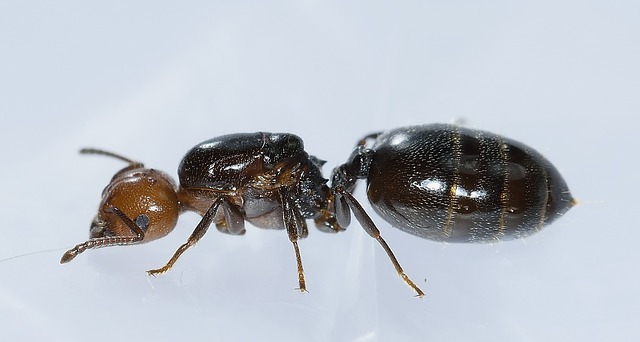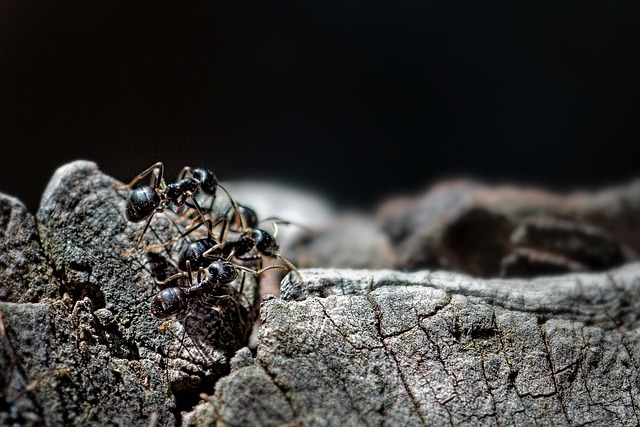When it comes to indoor pests, black ants are a common sight in many households. However, not all black ants are the same. Carpenter ants, for example, are often mistaken for other black ant species but can cause serious damage to your home.
Unlike other black ants that simply scavenge for food, carpenter ants create nests within the wooden structures of your home, burrowing through the wood and causing structural damage.
While they may not cause immediate harm, other black ant species can be a nuisance by invading your pantry or simply being an eyesore. Check out our blog, where we’ll tell you everything you need to know about carpenter ants vs. black ants.
Types of Black Ants
A variety of black ant species could lurk in your home, each with unique traits and tendencies. Understanding what pest lives indoors can help prevent further food and home damage.

The Carpenter Ant – As the name implies, carpenter ants have a love affair with wood. They tunnel into wood to build their nests, causing potential structural damage over time. These ants are generally larger than other species and are often black or dark brown.
The Pavement Ant – Pavement ants may be small in size, but they can be a big problem for homeowners. They earned their name from their tendency to make their nests in cracks and crevices in pavement, sidewalks, and driveways.
The Odorous House Ant – These ants have earned their moniker due to the pungent, foul odor they emit when crushed. They’re small in size, measuring about 1/10 of an inch in length, and typically range from light to dark brown, often appearing black in color. They’re particularly fond of sugary treats and venture inside homes searching for a sweet fix.
The Acrobat Ant – As their name suggests, these ants are most known for their acrobatic displays, arching their abdomens over their heads when threatened. They’re small, approximately 1/8 inch in size, and usually brown or black.
Curious about carpenter ants vs. black ants you may see in your Middletown home? Check out our deep dive into some common species below!
Carpenter Ants
Carpenter ants are the carpenters of the ant world, but instead of building houses, they make their homes in yours! These sneaky insects can cause significant damage to your home if left unchecked, but don’t worry. We’re here to shed some light on these curious critters.
These ants love wooden structures, habitually excavating them to create their nests. Unlike termites, which consume the wood they tunnel into, carpenter ants only remove the soft parts of the wood, leaving the hard exterior intact. This often creates a maze of galleries and chambers that can weaken the structure of your home over time.
So, how do you know if you have carpenter ants? Well, one telltale sign is the presence of large, black ants inside your home, especially near windows and doors.
You might also hear a faint rustling or tapping sound of the ants tunneling into the wood. If you suspect you have carpenter ants, it’s essential to act quickly. The longer you wait, the more damage they’ll cause.
The good news is that you can control carpenter ants with the help of a pest control professional. Pest specialists have the expertise and experience to identify carpenter ants and determine the best course of action to control them.
Here at United States Pest Service, we also have access to professional-grade products that are not available to the general public, which can help to control the ants more effectively and efficiently.
Pavement Ants
Pavement ants are a type of ant that makes its home in and around the pavement. These small, brown or black insects have distinctive ridges on their head and thorax. They’re common pests in many parts of the world, often nesting in pavement cracks, masonry walls, and other areas close to the ground.
These pests are omnivores, meaning they’ll eat just about anything, including other insects, dead animals, and human food. They’re particularly fond of sweet foods like nectar and honeydew and may forage inside homes in search of a sugar fix.
One of the most distinctive characteristics of pavement ants is their tendency to build large, sprawling colonies. These colonies can contain thousands of individual ants and grow around eighteen to twenty feet in diameter.
Here’s a video that explains how ant mounds work!
While it’s relatively easy to tell carpenter ants vs. these black ants apart, pavement ants are still a nuisance for homeowners. They swarm inside homes for food and quickly become a significant problem. Additionally, their large colonies can be difficult to control using DIY methods.
That’s why it’s important to trust a pest control professional when dealing with pavement ant issues. These experts will be able to determine the source of the problem and implement a targeted solution to control the colony and prevent future infestations.
If you’re dealing with a pavement ant problem, don’t wait! These persistent pests won’t go away on their own. Contact us today to take back your home and keep pavement ants at bay.
Odorous House Ants
Odorous house ants are small, dark-colored ants found throughout the United States. They get their name from the distinct, foul odor they emit when crushed, which has been described as having a rotting coconut scent.
They are opportunistic feeders, eating anything they find indoors. Like most ants, they’ll flock to sweet foods but won’t pass up other insects or savory food options.
Unfortunately, odorous house ants can be a nuisance for homeowners. Their characteristic smell and endless precedence inside can make them a tough ant to beat. While regular cleaning and storebought options can keep them at bay, we suggest giving us a call whenever you struggle with an infestation.
Carpenter Ants vs. Black Ants
Carpenter ants and other common black ants can look similar at first glance, but they have several key differences that set them apart. Understanding these differences is crucial if you’re trying to determine the best way to control them.
One of the most apparent differences between carpenter ants vs. black ants is their size. Carpenter ants are typically larger, with workers ranging from 1/4 inch to 1/2 inch in length, making them easier to spot and distinguish from other black ants.
Another key distinction between carpenter ants and other black ants is their behavior. While most black ants are generally just a nuisance, carpenter ants can cause severe damage to your home.
They burrow into wood and other building materials, creating extensive galleries and tunnels as they go. This can weaken the structure of your home and make it more vulnerable to collapse.
Because carpenter ants typically build their nests inside wood, you may see holes or galleries in previously water-damaged wooden items. Odorous house ants or pavement ants usually build their nests outdoors in soil or other organic materials.
If you need help determining carpenter ants vs. black ants, it’s always best to consult a pest control professional. These experts will be able to accurately identify the species and recommend a course of action to control them and prevent future infestations.

